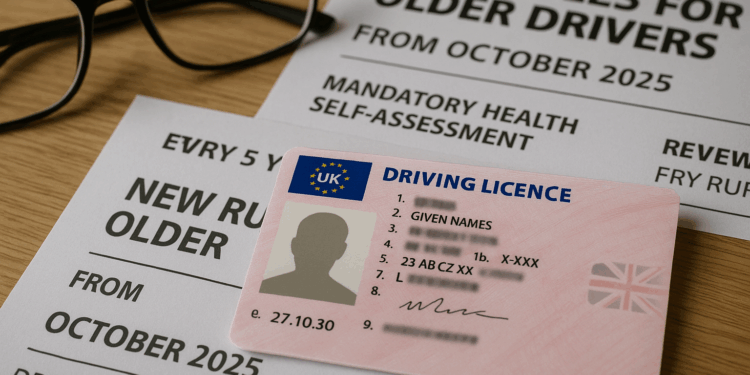Story Highlight
– New rules for drivers aged 55 and above announced.
– Licence renewals every five years starting October 2025.
– Mandatory health and vision self-assessments required.
– Digital renewals encouraged for faster processing times.
– Optional “fitness-to-drive” certificates for professional drivers available.
Full Story
Motorists in the UK are anticipated to encounter significant changes that will particularly affect drivers aged 55 and over. The Department for Transport has noted a noticeable increase in the number of older drivers, which has prompted concerns regarding the safety of this demographic on the roads. Various medical conditions, such as vision impairments, decreased reaction times, and long-term health issues, can increase the risks associated with driving at an older age. In light of these factors, the government is instituting new regulations to maintain high road safety standards.
Scheduled to take effect on 27 October 2025, the updated regulations aim to enhance the driving licence system in the UK. The initiative is designed to improve not only the standards of road safety but also to ensure greater transparency regarding medical fitness among older drivers, as well as streamline the process for renewing driving licences. These changes reflect a balance between allowing older drivers to maintain their independence while introducing necessary safety measures for the benefit of all road users.
The updates pertain to various aspects of the driving licence process, including the frequency of renewals, mandatory health assessments, and eyesight requirements. Officials from the Department for Transport and the Driver and Vehicle Licensing Agency (DVLA) have emphasized that these changes are not intended to impose unnecessary restrictions on older drivers. Instead, they aim to “enhance safety through awareness and responsibility,” according to a spokesperson from the DVLA.
Among the primary changes introduced, drivers aged between 55 and 69 will be required to renew their driving licences every five years instead of the current ten-year cycle. This adjustment will mean that older drivers will undergo more regular reviews of their suitability to drive.
Additionally, the new regulations will require drivers over the age of 55 to complete a straightforward health and eyesight self-assessment form at each renewal. Those who report certain medical conditions—including diabetes, epilepsy, or cardiovascular issues—will be required to obtain confirmation from their general practitioners. This measure aims to ensure that those with potentially incapacitating conditions are monitored appropriately.
The DVLA is also moving towards a digital-first renewal system, encouraging drivers to use its online portal for quicker processing times and reduced delays. Although paper-based renewal options will remain available, they are likely to result in longer waiting periods for those opting not to utilise the digital system.
For professional drivers, such as those involved in deliveries, bus services, or taxi operations, there is an option to acquire a “fitness-to-drive” certification. This voluntary certification would confirm an individual’s medical and vision suitability for driving and could serve to meet employer insurance requirements.
Road safety advocates have welcomed these changes, suggesting that they represent a significant step towards ensuring that all drivers, particularly older individuals, are fit to operate vehicles safely. This is particularly crucial as a growing number of older people remain active and independent in their later years.
Community organisations that support older drivers argue that while safety measures are essential, it is equally important to accommodate the needs of this demographic. They stress the value of providing educational resources that can empower older drivers to assess their own fitness and make informed decisions about their driving capabilities.
As the rollout of these new regulations approaches, many stakeholders are considering how best to implement them in a way that promotes road safety while respecting the independence of older motorists. Transport officials are expected to conduct a series of consultations to refine these new rules further and address potential concerns from the community.
In conclusion, while the forthcoming updates to the driving licence system in the UK mark a significant shift in how older drivers will be assessed, the overarching goal remains to enhance road safety for all users. As the government prepares to implement these changes, the focus will be on fostering a culture of safety, responsibility, and awareness among older drivers.























These changes are a sensible step toward balancing independence and safety. Regular five year renewals with health and vision self checks should help identify risk factors earlier and encourage drivers to seek medical advice when needed. Encouraging digital renewals will streamline the process, but support must be available for those less comfortable online. Clear guidance on completing the assessments and accessible routes for professional drivers to obtain fitness to drive certification will be important to avoid unintended penalties and maintain mobility for older people.
These measures strike a sensible balance between maintaining mobility and protecting road users. Regular five year checks with simple health and vision self assessments should help identify issues early while avoiding unnecessary bureaucracy. Encouraging digital renewals will speed up the process and reduce administrative burden for both drivers and agencies. It will be important that consultations listen to older drivers and make guidance clear and accessible so that those who need support can get it without losing their independence.
These measures strike a sensible balance between road safety and personal independence. Regular five year renewals with mandatory health and vision self checks should help identify issues early and reduce risk without imposing unnecessary burden. Encouraging digital renewals will make the process more efficient and accessible, while the fitness to drive option for professional drivers provides a clear route for those with higher standards to remain compliant. Careful consultation with communities will be important to ensure concerns are heard and vulnerable groups supported during implementation.
Regular checks that focus on health and vision can help identify issues early and reduce collision risk while supporting older drivers to stay safe on the road. It will be important that guidance is clear, accessible and backed by timely support services so people can complete assessments without losing independence. Encouraging digital renewals is sensible but alternative routes must remain available for those who are less comfortable online. Clear communication about what the checks involve and how to get help will build public confidence and make the transition smoother.